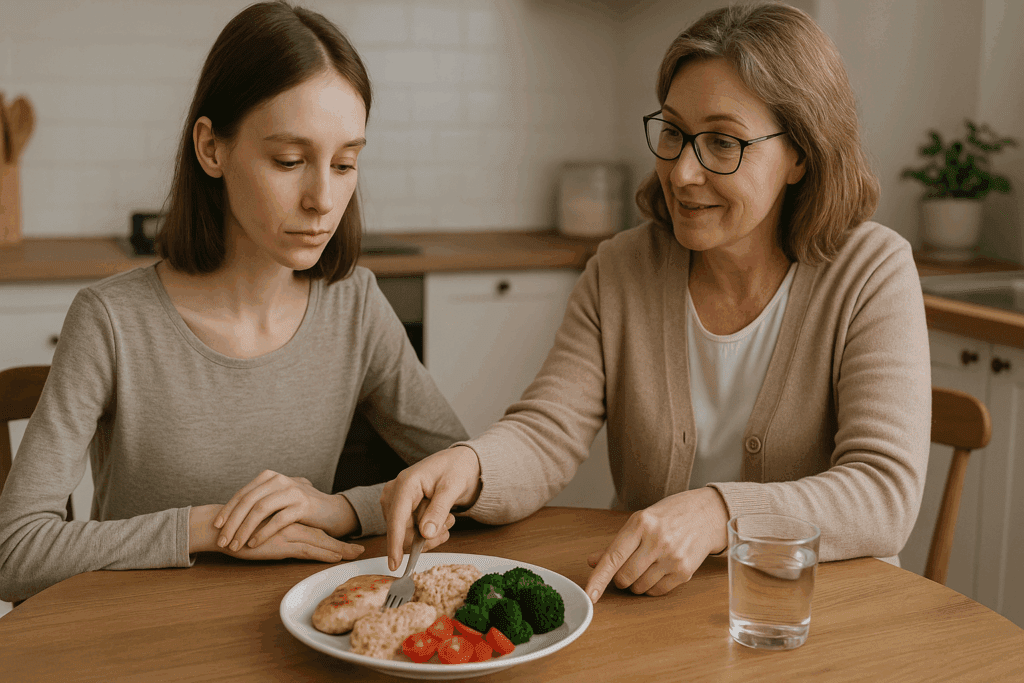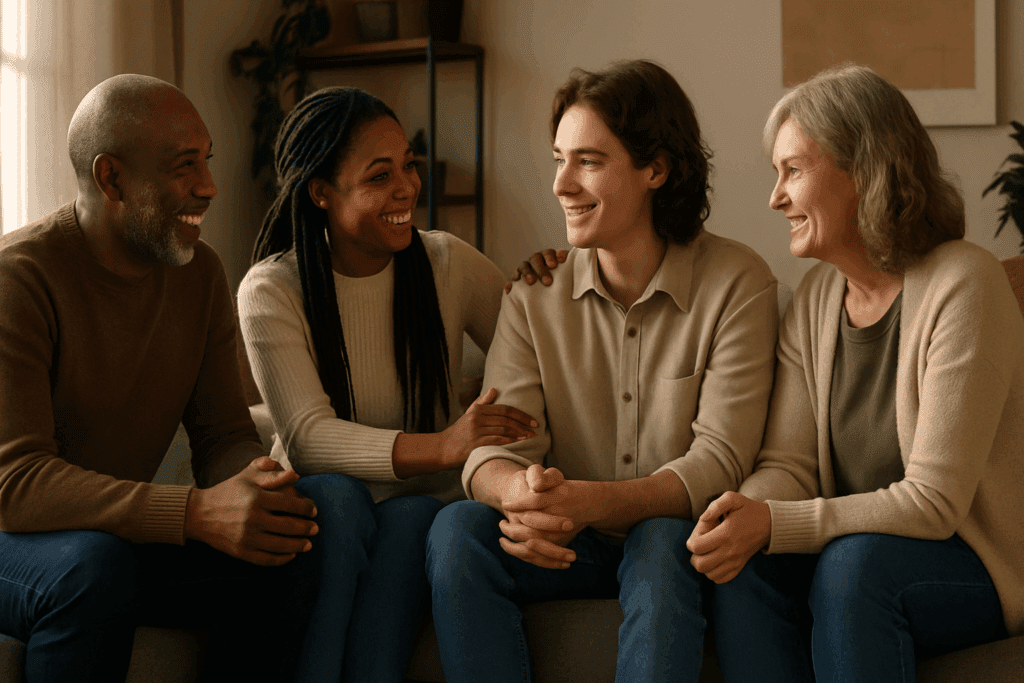Understanding Anorexia Nervosa and Its Complex Nature
Anorexia nervosa is a severe eating disorder marked by restrictive eating patterns, an intense fear of gaining weight, and a distorted body image. Unlike general dieting or temporary food avoidance, this condition reflects a deeply rooted psychological and physiological imbalance that affects every facet of a person’s life. Individuals struggling with anorexia often experience both physical and emotional symptoms, which can lead to life-threatening complications if left untreated. As such, understanding anorexia nervosa is a crucial first step for anyone seeking to provide meaningful support.
You may also like: How to Stop Emotional Eating and Regain Control: Mindful Nutrition Strategies That Support a Healthier Lifestyle
The condition is not merely about food or weight; it is often a manifestation of deeper psychological distress. Many individuals with anorexia report feelings of unworthiness, perfectionism, and a need for control. These emotional factors can create a complex web that perpetuates the disorder, making it difficult to overcome without targeted interventions. Furthermore, anorexia nervosa is frequently accompanied by co-occurring mental health conditions such as anxiety, depression, or obsessive-compulsive disorder, which must also be addressed in a comprehensive treatment plan. For those wondering how to help someone with anorexia nervosa, it is essential to recognize the multi-dimensional nature of the illness and approach recovery with patience and compassion.

Identifying the Warning Signs and Taking the First Steps
Recognizing the signs of anorexia can be challenging, particularly because many individuals become adept at hiding their behaviors. Nevertheless, early intervention is critical in improving long-term outcomes. Physical symptoms such as noticeable weight loss, fatigue, dizziness, and gastrointestinal problems may be apparent, but emotional and behavioral changes are often more telling. These can include obsessive calorie counting, avoidance of meals, excessive exercise, and social withdrawal.
If you’re concerned about how to help someone with an eating disorder, approaching the subject with sensitivity is key. Begin with a private, nonjudgmental conversation where you express your concern out of genuine care rather than confrontation. Avoid commenting on their appearance or weight, and instead focus on observed behaviors and emotional well-being. Offer to assist them in finding professional help, and be prepared for resistance. Many individuals with anorexia deny their condition or fear losing control, which makes early support all the more important. Learning how to help a friend with an eating disorder starts with active listening, consistent emotional support, and persistence in encouraging treatment.

The Role of Nutrition in Anorexia Nervosa Recovery
Nutrition is a cornerstone in the recovery process for anorexia nervosa, yet reintroducing food can be one of the most emotionally fraught aspects of treatment. Malnutrition affects every organ system, impairing brain function, hormonal balance, and cardiovascular health. Correcting these deficits requires a carefully designed nutritional rehabilitation plan tailored to the individual’s unique needs. Registered dietitians who specialize in eating disorder treatment play a crucial role in guiding this process and preventing the complications of refeeding syndrome, which can occur when nutrition is restored too rapidly.
It is vital to understand that nutritional recovery is not just about weight restoration—it’s about reestablishing a healthy relationship with food. This often includes structured meal plans, nutritional counseling, and gradual exposure to previously feared foods. If you’re exploring how to help people with eating disorders, supporting their nutritional journey means removing judgment and fostering a sense of normalcy around eating. For family members and caregivers, learning how to support someone with anorexia through meals may involve modeling balanced eating behaviors, avoiding food-related conflict, and collaborating with clinical professionals.

How Therapy for Anorexia Nervosa Supports Emotional Healing
Therapy is an essential component of anorexia therapy treatment, targeting the underlying psychological drivers of the disorder. Cognitive-behavioral therapy (CBT) is widely regarded as one of the most effective approaches. It focuses on identifying and modifying distorted thoughts and behaviors related to food, body image, and self-worth. Family-based therapy (FBT) is particularly beneficial for adolescents, involving parents directly in meal supervision and emotional support, often resulting in higher recovery rates.
In addition to CBT and FBT, other therapeutic modalities such as dialectical behavior therapy (DBT), interpersonal therapy (IPT), and acceptance and commitment therapy (ACT) may also be integrated into a personalized treatment plan. These approaches address emotional regulation, relationship patterns, and values-based decision-making. When considering how to help someone with anorexia nervosa, encouraging therapy and facilitating access to licensed professionals is one of the most meaningful contributions a loved one can make. Therapy for anorexia nervosa does not offer quick fixes, but it provides the necessary tools for long-term recovery and resilience.
Lifestyle Adjustments That Complement Professional Treatment
While clinical treatment forms the backbone of anorexia nervosa recovery, lifestyle changes can significantly enhance and reinforce the healing process. Creating a supportive and low-stress environment at home can help individuals feel safe during recovery. Reducing exposure to triggering content—such as weight-focused media, diet talk, and fitness culture—can shield individuals from harmful comparisons and unrealistic body ideals.
Encouraging gentle forms of movement, such as yoga or mindful walking, can be beneficial once a healthcare provider deems physical activity safe. These activities can help rebuild trust in the body without the compulsive drive often associated with exercise in eating disorders. Building a daily routine that incorporates self-care, adequate sleep, and stress management can also create a more stable foundation for healing. If you’re learning how to help someone with an eating disorder, these lifestyle strategies demonstrate that support goes far beyond mealtime—it is about creating a life that nourishes both mind and body.
Building a Recovery-Oriented Support System
No one recovers from anorexia alone. A recovery-oriented support system can make the difference between temporary improvement and lasting change. Friends and family members must educate themselves on the nuances of the disorder, dispelling myths and avoiding blame-based language. Understanding how to help a person with an eating disorder means becoming a reliable source of encouragement rather than a food monitor or enforcer of rules.
Effective support also involves recognizing one’s limitations. While empathy and encouragement are essential, so is knowing when to involve trained professionals. If you’re wondering who treats anorexia most effectively, look for multidisciplinary teams that include therapists, dietitians, medical doctors, and sometimes psychiatrists. Coordination among these professionals ensures that all aspects of health—physical, emotional, and behavioral—are addressed. Ultimately, how to help someone with anorexia nervosa requires a village approach, where each member contributes compassion, consistency, and accountability.

Educational Strategies: Helping Others Understand Anorexia Nervosa
Increasing public awareness about eating disorders can reduce stigma and promote early intervention. Educational outreach in schools, workplaces, and community settings can help individuals recognize the symptoms of anorexia and understand the importance of timely treatment. Learning how to support someone with an eating disorder is not just for family members or close friends; it’s a communal responsibility that can save lives.
Programs designed to teach body positivity, media literacy, and emotional regulation have shown promise in preventing the onset of disordered eating behaviors. Incorporating these educational strategies into broader wellness initiatives can create environments that promote psychological resilience. Additionally, sharing stories of recovery and hope can inspire those currently struggling, while also informing others about the realities of anorexia therapy. For those asking, “Can anorexia be cured?” the answer lies not only in individual treatment but in shifting societal attitudes toward food, bodies, and mental health.
Navigating Setbacks and Maintaining Long-Term Recovery
Recovery from anorexia is rarely linear. Setbacks are common, and individuals may oscillate between progress and relapse. Understanding this dynamic is vital for anyone offering support. When setbacks occur, it’s important not to react with frustration or disappointment. Instead, focus on reinforcing the skills and insights gained during treatment. Reassure the individual that setbacks do not equal failure but rather are an expected part of the healing journey.
Ongoing check-ins with mental health professionals, regular nutritional assessments, and continued therapy can help prevent relapse and promote stability. Encouraging open dialogue about challenges, whether emotional or practical, keeps communication channels open and fosters trust. If you’re exploring how to help someone with anorexia nervosa over the long term, it involves patience, flexibility, and a deep understanding that healing often happens in layers. Maintaining long-term recovery is about resilience—both for the person in recovery and their support network.

Testing and Diagnosis: When and How to Seek Medical Confirmation
While visible symptoms may raise concerns, formal diagnosis is essential for appropriate intervention. The process of testing for anorexia nervosa typically involves a comprehensive evaluation by healthcare professionals, including physical exams, lab tests, and psychological assessments. These evaluations help rule out other medical conditions and establish a clear diagnosis based on DSM-5 criteria.
Parents, partners, and friends may feel uncertain about when to recommend testing. If you notice persistent eating restrictions, rapid weight loss, and signs of emotional distress, it is appropriate to consult a primary care physician or mental health specialist. The earlier the diagnosis, the better the prognosis. Understanding the importance of early detection and how to help people with eating disorders navigate medical systems is a fundamental component of support. Diagnosis is not a label—it’s a tool that opens the door to evidence-based treatment and healing.

The Hope in Treatment: Can Anorexia Be Cured?
One of the most frequently asked questions is whether anorexia can be cured. While the term “cure” may imply a permanent, problem-free resolution, the reality is more nuanced. Many individuals achieve full recovery, returning to healthy eating patterns, stable weight, and a renewed sense of self. Others may experience lingering thoughts or triggers but learn to manage them effectively with ongoing support. Anorexic treatment is most effective when personalized, sustained, and multifaceted.
Combining medical care, therapy, nutritional counseling, and lifestyle changes creates a comprehensive framework that supports lasting improvement. Encouragingly, longitudinal studies show that with early intervention and consistent care, a significant percentage of individuals with anorexia go on to lead fulfilling lives. When considering how to help anorexia nervosa recovery unfold, it’s crucial to emphasize that progress—not perfection—is the goal. Recovery may not erase all past struggles, but it can empower individuals to reclaim their lives and rediscover joy in living.
Frequently Asked Questions About Helping Someone with Anorexia Nervosa
What should I do if the person I’m trying to help denies having anorexia nervosa?
It’s not uncommon for individuals with anorexia to deny their condition or minimize its severity. Denial often stems from fear, shame, or a deep need for control, making it one of the most challenging barriers when considering how to help someone with anorexia nervosa. The key is to remain calm and patient. Avoid pressing them to admit they have a problem; instead, focus on expressing your concern for their well-being without judgment. Continuing to show up as a consistent and caring presence can eventually build the trust necessary for them to accept support and explore anorexia nervosa treatments.
How can I offer support without making food the focus of every interaction?
Understanding how to help someone with an eating disorder means recognizing that food is only one part of a much larger picture. Emotional support, shared activities, and genuine connection are equally important. Try engaging them in non-food-related conversations or hobbies they enjoy. Offer companionship for activities like walks, journaling, or attending support groups together. By showing that your support goes beyond meals, you’re reinforcing that they are valued as a whole person—not just in relation to their eating behaviors or appearance.
Is it ever appropriate to set boundaries with someone recovering from anorexia?
Absolutely. One of the most overlooked aspects of how to support someone with anorexia is knowing when and how to set healthy boundaries. If their behavior becomes harmful to themselves or others, or if it begins to affect your own mental health, boundaries become necessary. Examples might include refusing to participate in body-checking conversations, avoiding triggering environments, or stepping back from mealtime supervision if it causes excessive distress. Supporting someone doesn’t mean sacrificing your well-being; in fact, strong boundaries often create a safer and more stable support environment for both parties.
What if professional treatment doesn’t seem to be helping them?
When anorexia therapy treatment appears to be stagnating, it can be deeply discouraging for loved ones. However, anorexic treatment is rarely linear and often requires trial and error across different approaches. Not every therapy for anorexia nervosa is equally effective for every individual. If you’re wondering how to help people with eating disorders in such cases, encourage second opinions or alternative methods—such as experiential therapies, trauma-informed care, or nutritional psychiatry. Sometimes, switching therapists or treatment settings (like moving from outpatient to residential care) can catalyze new breakthroughs in recovery.
Can someone with anorexia still appear physically healthy?
Yes, and this reality complicates how to help anorexia nervosa recovery efforts. Individuals with atypical anorexia may be within or above a “normal” weight range and still experience serious medical complications. Focusing solely on weight can delay diagnosis and overlook psychological distress. This is why learning how to help a person with an eating disorder means tuning into emotional, behavioral, and relational cues—not just physical signs. If there’s persistent anxiety around food, distorted body image, or compulsive behaviors, these should be taken seriously even in the absence of visible weight loss.
How can I help if I live far away from the person struggling with anorexia?
Supporting someone long-distance comes with unique challenges, but it’s still possible to have a meaningful impact. Regular phone or video calls can help reduce isolation, and sending thoughtful messages, books, or care packages shows you’re thinking of them. Learning how to help a friend with an eating disorder remotely may also involve researching local treatment options in their area or encouraging them to explore telehealth therapy for anorexia nervosa. Technology makes it easier than ever to offer emotional presence even when physical presence isn’t feasible.
What role do siblings and extended family members play in supporting recovery?
While parents and partners often lead the support effort, siblings and extended family can offer a unique form of relational stability. Cousins, aunts, and even grandparents can contribute by maintaining connection and reinforcing positive self-image through non-judgmental conversation and consistent support. In family therapy settings, involving these individuals can provide a broader base of accountability and care. Understanding how to help someone with anorexia nervosa as a family system means embracing every willing member as a potential advocate, educator, and emotional anchor.
Is it helpful to talk openly about recovery successes and milestones?
Absolutely—when done with care. Celebrating non-weight-related milestones such as attending therapy sessions, reintroducing a feared food, or expressing difficult emotions can reinforce positive behaviors. These moments offer encouragement and show that progress is recognized and appreciated. When considering how to support someone with an eating disorder, focusing on emotional resilience rather than appearance reinforces intrinsic motivation. However, it’s also important not to over-celebrate or place pressure on these moments, as that can inadvertently create anxiety or fear of relapse.
How can I educate myself beyond mainstream information on anorexia nervosa?
If you’re serious about learning how to help people with eating disorders in a deeper way, consider exploring clinical literature, podcasts by recovered individuals, or specialized seminars by eating disorder professionals. Understanding advanced anorexia tips often involves diving into lesser-discussed topics such as neurobiology, trauma response, and the social determinants of mental health. You might also look into research on newer anorexia therapy models like Compassion-Focused Therapy or Polyvagal Theory. Investing in your own education not only strengthens your ability to support others but also helps reduce stigma by spreading accurate, up-to-date information.
How do I respond if someone relapses after appearing to recover?
Relapse can be heartbreaking, but it’s also a common part of the healing process. Rather than viewing it as a failure, it’s more constructive to see it as a sign that certain needs are still unmet. Revisit the support structures that were in place—has something changed in their environment, relationships, or stress levels? If you’re asking how can I help someone with anorexia after a relapse, begin by re-engaging with therapy, possibly adjusting the anorexia nervosa treatments being used, and reassuring them that they are not back at square one. Relapse does not erase progress; it simply invites a renewed commitment to healing.
Conclusion: Supporting Anorexia Nervosa Recovery with Compassion and Commitment
Helping someone recover from anorexia nervosa is an act of profound empathy, commitment, and ongoing learning. It is not simply a matter of encouraging someone to eat more or gain weight—it’s about addressing the intricate psychological, emotional, and physiological roots of a serious illness. For those seeking to understand how to help someone with anorexia nervosa, the journey begins with education, patience, and an unwavering belief in the possibility of healing.
The most effective anorexia nervosa treatments are collaborative, integrating therapy, nutritional guidance, medical care, and supportive lifestyle changes. Whether you’re wondering how to help a friend with an eating disorder or how to support someone with anorexia in your family, your role can be transformative. Remember, recovery is not a destination but a continuous process—a series of choices, setbacks, and triumphs that ultimately lead to a more balanced and empowered life. By embracing a holistic approach rooted in compassion, you can be a guiding light in someone’s path toward healing and renewal.
Was this article helpful? Don’t let it stop with you. Share it right now with someone who needs to see it—whether it’s a friend, a colleague, or your whole network. And if staying ahead on this topic matters to you, subscribe to this publication for the most up-to-date information. You’ll get the latest insights delivered straight to you—no searching, no missing out.

